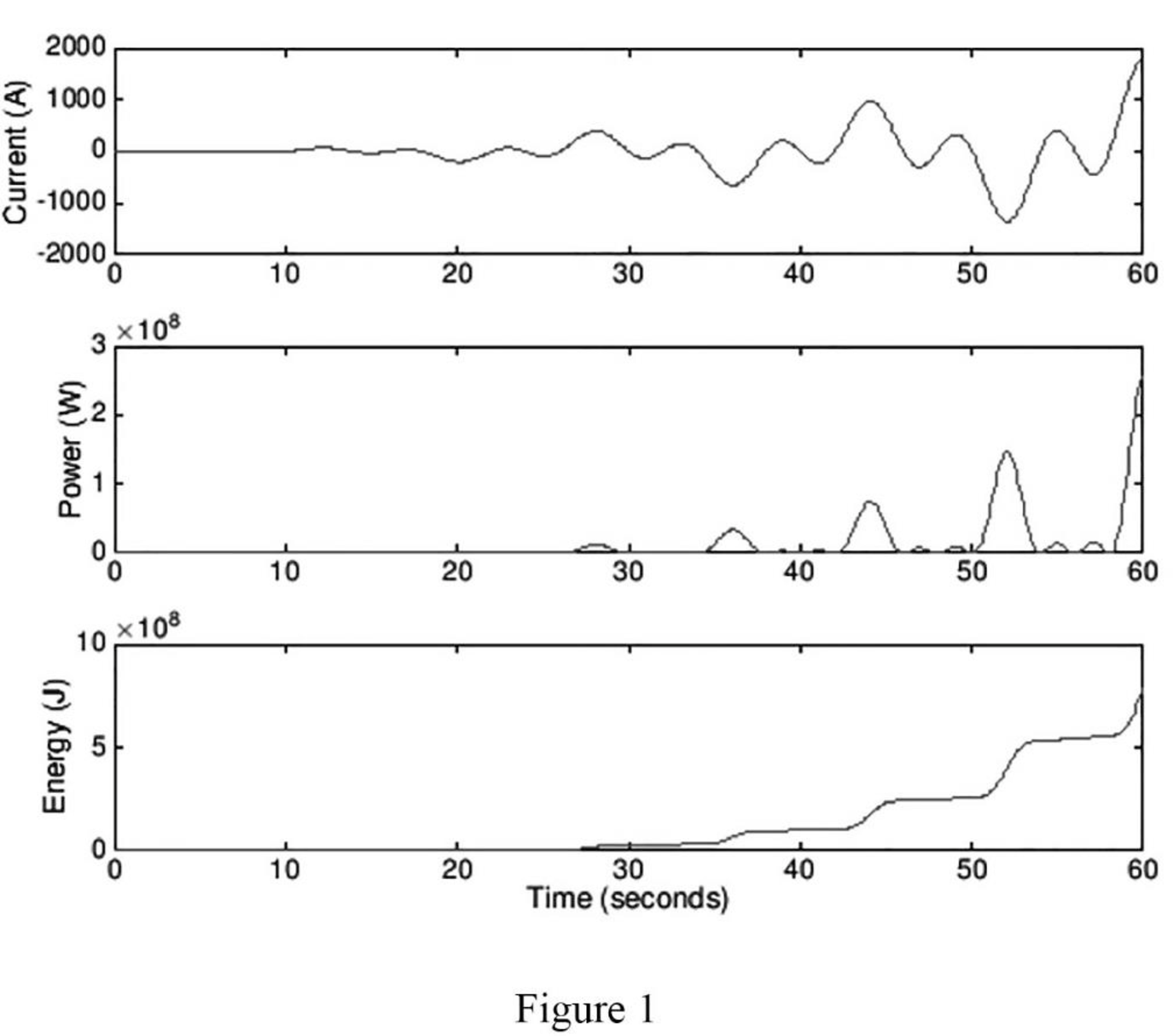
Concept explainers
A wind power system with increasing windspeed has the current waveform described by the equation below, delivered to an 80 Ω resistor. Plot the current, power, and energy waveform over a period of 60 s, and calculate the total energy collected over the 60 s time period.
Sketch the current, power, and energy waveform over a period of 60 s to the current waveform of the wind power system. Also calculate the total energy collected over the 60 s time period.
Answer to Problem 22E
The plot for the current, power, and energy waveform is sketched as shown in Figure 1, and the total energy collected over the 60 s time period is
Explanation of Solution
Given data:
The current waveform is,
The resistor is
Formula used:
Write the general expression to find the power as follows,
Write the general expression to find the energy as follows,
Calculation:
Substitute the value of
Applying equation (3) in equation (2) as follows,
Consider the function,
Consider
Substituting the values in equation (5) as follows,
Consider,
Applying the product to sum formulas in the above expression as follows,
Consider,
By applying integration by parts in the above expression,
Applying the values in equation (8) as follows,
Consider the function,
Solving,
By applying integration by parts in the above expression,
Applying the values in the above equation as follows,
Consider,
Solving,
By applying integration by parts in the above expression,
Applying the values in the above equation as follows,
Consider,
Solving,
By applying integration by parts in the above expression,
Applying the values in the above equation as follows,
Consider,
Let,
Applying the values in the above expression,
Substituting the values in equation (13) as follows,
Substitute the above value in the considered expression
Substitute the above value in equation (12) as follows,
Substitute the above value in equation (11) as follows,
Substitute the above value in equation (10) as follows,
Substitute the above value in equation (9) as follows,
Consider the function
Applying integration by parts in the above expression,
Applying the values in the above equation as follows,
Consider,
Let,
Applying integration by parts in the above expression,
Applying the values in the above equation as follows,
Consider,
Let,
Applying integration by parts in the above expression,
Applying the values in the above equation as follows,
Consider,
Let,
Applying integration by parts in the above expression,
Applying the values in the above equation as follows,
Consider,
Let,
Substituting the values,
Substitute the above value in equation (22) as follows,
Substitute the above value in equation (21) as follows,
Substitute the above value in equation (20) as follows,
Substitute the above value in equation (18) as follows
Substitute the above value in equation (17) as follows
Substitute the above value in equation (16) as follows
Substitute the above value in equation (15) as follows
Consider the function
Applying integration by parts in the above expression,
Applying the values in the above equation as follows,
Consider,
Let,
Applying integration by parts in the above expression,
Applying the values in the above equation as follows,
Consider,
Let,
Applying integration by parts in the above expression,
Applying the values in the above equation as follows,
Consider,
Let,
Applying integration by parts in the above expression,
Applying the values in the above equation as follows,
Consider,
Let,
Applying the values in the above equation as follows,
Substitute the above value in equation (33) as follows,
Substitute the above value in equation (31) as follows,
Substitute the above value in equation (30) as follows,
Substitute the above value in equation (29) as follows,
Substitute the above value in equation (28) as follows,
Substitute the above value in equation (26) as follows,
Substitute the above value in equation (25) as follows,
Consider the function
Substitute the calculated values of equation (34), (35), (23), and (14) in the expression x as follows,
Substitute the above value in equation (6) as follows,
Substitute
Applying the limits to the above expression over a period of 60 s,
Matlab code to plot for wind power waveform:
t_end = 60; % End time in seconds
t_pts = 600; % Number of points for time vector
t=linspace(0,t_end,t_pts); % Define time vector
dt=t_end/t_pts; % Separation between time points
R=80; % Resistance in ohms
for i=1:t_pts; % Iterate for each point in time
current(i)=0.5*t(i)^2*sin(pi/8*t(i))*cos(pi/4*t(i));
p(i)=current(i)^2*R;
end
w=cumsum(p)*dt; % Energy from cumulative sum times time separation
figure(1)
subplot(3,1,1); plot(t,current,'r'); % Plot voltage
ylabel('Current (A)');
subplot(3,1,2); plot(t,p,'r') % Plot power
ylabel('Power (W)')
subplot(3,1,3); plot(t,w,'r') % Plot energy
xlabel('Time (seconds)')
ylabel('Energy (J)')
Matlab output:
Figure 1 shows the plot for the current, power, and energy waveform.

Conclusion:
Thus, the plot for the current, power, and energy waveform is sketched as shown in Figure 1, and the total energy collected over the 60 s time period is
Want to see more full solutions like this?
Chapter 2 Solutions
Loose Leaf for Engineering Circuit Analysis Format: Loose-leaf
 Introductory Circuit Analysis (13th Edition)Electrical EngineeringISBN:9780133923605Author:Robert L. BoylestadPublisher:PEARSON
Introductory Circuit Analysis (13th Edition)Electrical EngineeringISBN:9780133923605Author:Robert L. BoylestadPublisher:PEARSON Delmar's Standard Textbook Of ElectricityElectrical EngineeringISBN:9781337900348Author:Stephen L. HermanPublisher:Cengage Learning
Delmar's Standard Textbook Of ElectricityElectrical EngineeringISBN:9781337900348Author:Stephen L. HermanPublisher:Cengage Learning Programmable Logic ControllersElectrical EngineeringISBN:9780073373843Author:Frank D. PetruzellaPublisher:McGraw-Hill Education
Programmable Logic ControllersElectrical EngineeringISBN:9780073373843Author:Frank D. PetruzellaPublisher:McGraw-Hill Education Fundamentals of Electric CircuitsElectrical EngineeringISBN:9780078028229Author:Charles K Alexander, Matthew SadikuPublisher:McGraw-Hill Education
Fundamentals of Electric CircuitsElectrical EngineeringISBN:9780078028229Author:Charles K Alexander, Matthew SadikuPublisher:McGraw-Hill Education Electric Circuits. (11th Edition)Electrical EngineeringISBN:9780134746968Author:James W. Nilsson, Susan RiedelPublisher:PEARSON
Electric Circuits. (11th Edition)Electrical EngineeringISBN:9780134746968Author:James W. Nilsson, Susan RiedelPublisher:PEARSON Engineering ElectromagneticsElectrical EngineeringISBN:9780078028151Author:Hayt, William H. (william Hart), Jr, BUCK, John A.Publisher:Mcgraw-hill Education,
Engineering ElectromagneticsElectrical EngineeringISBN:9780078028151Author:Hayt, William H. (william Hart), Jr, BUCK, John A.Publisher:Mcgraw-hill Education,





